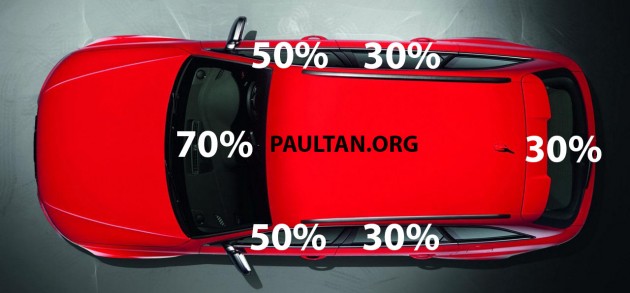The government’s announcement of new window tint regulations, which now allows the minimum visible light transmission (VLT) levels of the rear side windows and rear windscreen to be lowered to full black, has drawn a mixed reaction from the public.
The previous regulations – which were put in place in 2016 – stipulated that permissible VLT levels were 30% for the rear windows and the rear windscreen. The new guidelines, announced by transport minister Anthony Loke yesterday, do not stipulate a minimum VLT percentage and simply list “any” percentage, meaning that motorists can theoretically go to 0% VLT and entirely blacken out – or panelise – the rear of the car.
While motorists wanting a cooler mobile environment will no doubt be happy with the new ruling, not everyone thinks this is a wise idea, and it’s not just the police, which has voiced its displeasure at not being consulted on the new ruling and cited concerns about how the new rules could affect police work as well as the security of personnel.
There is also the question of road safety. The Malaysian Automotive Accessories Traders’ Association believes that the previous 30% rear VLT level was sufficient. Its president Lim Bee Choo said that those levels were “dark enough,” and anything less will affect visibility on the road, The Star reports.
“We welcome the ministry’s move to allow fully dark rear passenger windows. But we are concerned about road safety if the rear windscreen is allowed to go all dark. If the rear windscreen is fully darkened, what the driver sees through the rear view mirror will also be darkened. It may be okay during the day, but it will be a safety concern at night when the driver has poor visibility,” she said.
While the new rules are bound to see an increase in the installation of darker rear window tint films, Lim cautioned consumers about expectations. Based on feedback from its more than 600 members nationwide, she said many users regretted installing overly dark tint film on their rear windscreens.
“They realised how difficult it was to see the road clearly, especially when driving at night or in the rain, and then decided to remove their tint,” she said.
She said that a darker tint film did not mean greater heat-reflecting capability, and with most imported cars now coming with laminated windows with 18% to 25% VLT on their rear windscreens, there was less necessity to increase heat-cutting capability without raising road safety concerns. “If drivers insist on going all dark, they should install a better sensor or camera to avoid posing a danger on the road,” she said.
Others welcomed the move. National Road Safety Council member Tan Sri Lee Lam Thye said the new ruling was “appropriate in line with the climate condition” here. “For security concerns, I believe the ministry has taken into account the views of the public to allow for this new ruling. It is a welcome move for many drivers,” he said.
The existing regulations of a 70% VLT for the front windscreen and 50% for the front side windows remains unchanged, but can be bypassed with a RM5,000 fee, renewable every two years, for those with valid safety or health reasons.
Do you think the new guidelines to lower the permissible VLT levels for the rear windows and windscreen is a good move? Share your thoughts with us in the comments section.
Related Cars for Sale on
Source: Read Full Article












